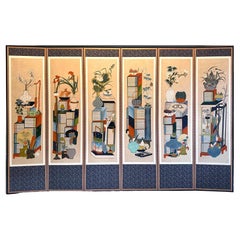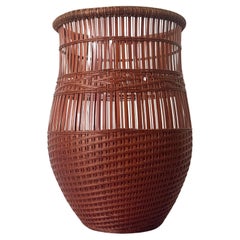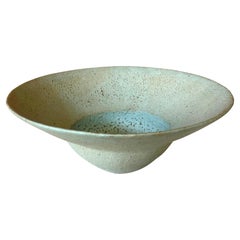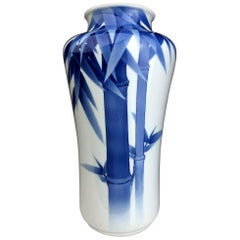TISHU
to
43
588
309
191
175
154
147
122
101
75
69
59
49
43
39
33
30
28
25
23
21
21
17
17
17
16
15
12
8
6
4
2
2
1
1
1
1
42
23
21
12
10
Korean Folding Chaekgeori Painted Scholar Floor Screen
Located in Atlanta, GA
A six-panel painted folding floor screen from Korea circa early 20th century. This type of screen is called Chaekgeori (books and things) which is quite unique to Korea. It became popular at the end of 18th century favored and encouraged by King Jeongjo (1752-1800) as a political tool to promote social conservatism such as the traditional Confucianism value, especially considered important in a time when waves of new ideology influx came to Korea. Initially commissioned for the royal court, they became increasingly popular with the scholars of noble and affluent household and used it widely in their halls and studies. Early screens were painted with trompe-l’oeil bookcases displaying books and arrays of collectibles. Later, the bookcases were eliminated to focus on the assemblage of neatly stacked books and objects of scholarly pursue. On this screen, the six panels were neatly presented and framed in woven brocade borders. Among the stacked volumes, one can find many fine porcelain vases with flowers, potted orchids, pen holders with brush pens and scroll paintings, incense burner, ink stone, teapot, fan with ink painting, vessels of fruits, exotic plants such as lotus, plumeria and even a pair of glasses. It feels like a pleasant visual measure hunting for the viewers. Several words in Chinese found their way into the picture as well, including filial (xiao), longevity (shou) and luck (fu).
The painting was done in a meticulous way with no details overlooked and also with a rather western still-life dimensional perspective. In a rather unusual maximal but also minimalistic way, the screen exudes a folky charm but appears modern at the same time.
Each panel is 17.5"w by 70.2"h.
For general information on the subject see reference: Chaekgeori the Power and Pleasure of Possessions in Korean Painted Screens...
Category
20th Century Korean Folk Art Paintings and Screens
Materials
Brocade, Silk, Wood, Paper
Japanese Contemporary Bamboo Basket by Abe Motoshi
By Abe Motoshi
Located in Atlanta, GA
A Japanese Ikebana basket woven by bamboo artist Abe Motoshi (Japanese, b. 1942). In an organic vase form with elegant, curved wall with reinfo...
Category
Late 20th Century Japanese Modern Scholar's Objects
Materials
Bamboo, Rattan
Korean Antique Bronze Footed Vessel with Lid Early Joseon Dynasty
Located in Atlanta, GA
A bronze bowl shape vessel with fitted lid from Korean dated to 15-16th century (early Joseon Dynasty). In an elegant minimalistic form with thin wall and supported by a high foot ri...
Category
Antique 16th Century Korean Other Metalwork
Materials
Bronze
Ceramic Bowl with Flanged Rim by John Ward
By John Ward
Located in Atlanta, GA
A stoneware glazed bowl by British studio potter John Ward (1938-2023) circa 1980-1990s of the last quarter of the 20th century. The bowl features a distinct form with a wide flanged...
Category
Late 20th Century English Modern Decorative Bowls
Materials
Ceramic
Japanese Porcelain Vase Makuzu Kozan Meiji Period
By Makuzu Kozan
Located in Atlanta, GA
A striking blue and white vase from the studio of Japanese Potter Makuzu Kozan, also known as Miyagawa Kozan (1842–1916), one of the most established and collected ceramist from Meiji Period. Born as Miyagawa Toranosuke, Kozan established his pottery studio in Yokohama circa 1870s and later became one of the appointed artists to the Japanese Imperial household. His work was exhibited in many international fairs that the Meiji government participated at the turn of the century and won many grand prizes.
Of a relatively large size, this vase is decorated with underglaze cobalt blue using the novel technique developed by Kozan called Fuki-e (the blow painting). As a result, the bamboos appear took on a three-dimensional quality as if appearing in a mist. Known as one of the most creative ceramists, circa 1887, Kozan started experimenting with new chemical colors from the West in the format of his porcelain glaze. New colors allowed him to create underglaze design that appeared bright, smooth and glossy. He even invented his own receipt of cobalt blue to achieve a much brighter yet softer shade, as evident on this vase. To create landscape that is realistic and dimensional, more common in the western paintings, he was inspired by the native Japanese ink painting technique developed around 1900 by Yokoyama Taikan...
Category
Antique Early 1900s Japanese Japonisme Ceramics
Materials
Ceramic




